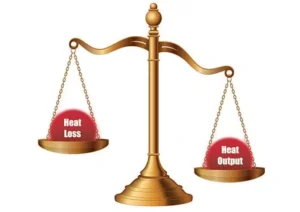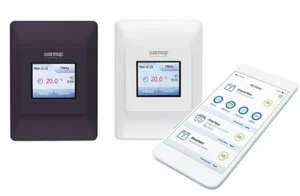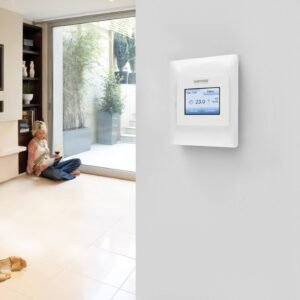
Electric Underfloor Heating: Costs And Benefits
It’s winter, and it’s cold. Seriously cold. It’s still dark outside and you’re snug as a bug under your duvet. You feel lucky with the electric blanket keeping you toasty warm.
But then the alarm goes off and it’s time to face reality: a bathroom where you can see your breath in the morning. The thought of getting out of bed doesn’t appeal in the slightest. You linger as long as you possibly can, but the kids wait, work waits.
So you throw back the blankets with a groan and you hurry to switch on the bathroom fan heater in the hope it’s going to make a difference. A coffee later, you can’t delay the shower any longer. So you undress as fast as you humanly can and hop into the scorching hot shower.
At least it’s warming the chill that has travelled through your bones. You relax. This feels so much better. But it can’t go on forever. You hate this moment with a vengeance. But you’re the brave type and you step out of the shower where your feet hit the cold floor.
It puts you in a foul mood and you promise yourself this has to end right here, right now. Surely, there is a better way… . Underfloor heating, maybe? As soon as your lunch break arrives, you start researching. And what you discover is a very pleasant surprise….
Bathroom Underfloor Heating

In recent years, electric underfloor heating (especially in bathrooms) has quickly become very popular in New Zealand. That’s partly because Kiwis are recognising it as one of the most sustainable ways of heating. But there’s a whole lot more to the story.
People realise that when done right, the operational costs of electric underfloor heating are considerably less than many other options. On top of that, the comfort of warm feet is next level.
Add the maintenance (or lack of) factor and you’ve got yourself a very sensible and appealing heating option.
Hydronic vs. Electric
There are two popular types of underfloor heating systems that are commonly used in New Zealand: Hydronic and Electric. The names ‘wet system’ or ‘hot water fed’ and ‘wire systems’ are also common.
The type of flooring, the location you want to install underfloor heating, whether you are building a new home or planning an upgrade to your existing house and your budget are all determining factors.
Hydronic Underfloor Heating
In a hydronic underfloor heating system, the installer lays a series of pipes on a sub-floor before the final floor goes over the top. Hot water is then pumped through the pipes that are connected to the water boiler or heat pump hot water cylinder.
This makes a hydronic system economical to run, but very expensive to install. It’s fair to say installation isn’t something you do on a whim; it’s quite a job. So to make the investment worth its while, hydronic underfloor heating is usually a hot water heating option for the entire house. It’s especially appealing for newly built large open-plan houses with concrete polished floors.
In addition, hydronic underfloor heating systems should be serviced yearly, to keep them at their optimum performance.
Because of the expenditure, it’s by and large only an option that is considered by people who plan to spend a long time living in the new home.
Good to know. But not what you’re looking for.
Electric Underfloor Heating
In New Zealand, electric underfloor heating is the most popular type.
As a rule of thumb, an electric underfloor heating system comprises resistance colour coded cable that is coiled beneath the existing floor and connected to the mains electricity supply. Sometimes, it’s installed in the form of a mat.
During your search, you find out that it’d be easy to bang all electric underfloor heating under the same umbrella, but depending on your type of flooring and your approach there is an array of different options.
Inslab Electric Heating
Simply put, inslab electric heating is the electric equivalent to the hydronic system. It suits new builds with concrete slab flooring. For existing homes, it’s not really an attractive option.
Electric Underfloor Heating for Carpet and Wooden Floors
Next, you find out that contrary to popular belief, it’s possible to use electric underfloor heating with carpet or wood (or laminate) flooring. But considering you’re looking for options that work for a bathroom, it’s not very relevant to you.
So you move on.
Electric Undertile Heating
Last but not least, there is the option of electric undertile heating. Electric undertile heating is easy to install. It works for new builds and renovations alike. And bingo…it’s a popular choice for bathrooms and smaller spaces because of the much cheaper set-up cost and the flexibility it offers. Because an electric underfloor system is not as bulky as a hydronic system, you can usually avoid the need to raise the floor.
For you, you already have a heat pump in your main living area and you have no intentions of embarking on a new home built. Like most Kiwis who look into underfloor heating, it’s your bathroom that gets the attention.
So you make up your mind: electric undertile heating is the way to go.
Undertile Heating Cost In New Zealand
Knowing what suits your needs is one thing. Knowing if it also suits your budget is another matter altogether. Both boxes need to be ticked, so you reluctantly start delving into the cost of undertile heating. Soon enough, you work out there was no need to worry.
You figure out that the installation cost of an electric undertile system is a pleasant surprise. That is, even more, the case if you’re the handy type who likes to get into some DYI-ing. The installation of Warmup undertile heating by an accredited installer can cost as little as approx. $800 for an average size bathroom in Auckland. The cost includes the heating wire, labour, screed and installing a Dual-Touch thermostat.
Of course, installation cost and running cost are two different things. The installation cost of an electric undertile heating system pleasantly surprised you, the running cost is no different. For the above 4 sqm bathroom, you need to count on only about $5 per week for running the heating for 6 hours a day. The running costs will go down if you don’t really need it to be on for 6 hours a day.
Of course, that figure depends on the insulation of your house, whether you include underfloor insulation boards, the size of your room, and whether you want the undertile heating to act as the main source of heating or as a way to merely remove the cold feet chill of tiles.
Advantages of Bathroom Undertile Heating
With what you found out so far, you really like what you see.
But whenever the time comes to make important decisions, you have the habit to list the pros and cons to get a clear view of what’s in front of you.
Pros of Electric Undertile Heating
Comfort and luxury
- People often comment on how underfloor heating produces a very pleasant, even warmth. It makes your home feel like the luxurious haven you want it to be.
- When the heating elements are evenly spaced as they should be, the heat spreads around the (bath)room area very evenly. Careful installation now avoids unpleasant cold or hot spots later on.
- Tiled flooring and undertile heating are a combination made in heaven because of the high thermal conductivity and close to the tile surface proximity. Unlike some of the other underfloor heating systems that need to warm up the concrete slab first, the heat transfer from the wire to the tiles happens very quickly and effectively.
- You can make maximal use of the space you have. You avoid unsightly clutter that seems to act as a dust trap. Discrete and space saving come to mind.
- Undertile heating is silent. No need to say more.
- When you include a thermostat with your new undertile heating set-up, undertile heating systems are simple to operate, just set the controls to the desired level of heat.
- Also, no maintenance required.
Underfloor Heating Running Cost
- Installing an undertile heating solution is cheaper than you think. It’s even possible to do a good part of the work yourself with an easy-to-use DIY kit.
- Undertile heating is definitely not limited to entire home installations. It’s a perfect choice for a smaller area, like a kitchen or a bathroom. It’s also possible to control different zones independently from each other if that’s what works for your lifestyle.
- Underfloor heating increases the value of your home. For new homes bathroom, underfloor heating has become close to a necessity; for renovations of an older home, it’s a very smart investment.
- You can heat a smaller room like a bathroom for less than the cost of a coffee a week. Having your heating element at the lowest point in the room makes total sense when you consider that warm air rises. It makes for a very economical system. Use our calculator to check the approximate underfloor heating running costs.
Installation
- You can easily install undertile heating in an existing bathroom, either on top or below the waterproofing layer that is required for wet area.
- Generally speaking, electric undertile heating is easy to install around tricky areas such as showers, pedestal basins, vanities and toilets.
Health and Safety
- Unlike panel heaters, fan heaters and infrared heaters, undertile heating is completely safe for adventurous little fingers.
- People with allergies love undertile heating because dust mites don’t like the warm floor temperature. They also don’t cause air (and pollen) being blown around like fan heaters.
- Electric undertile heating systems help keep moisture-rich area such as bathrooms dry. Of course, less moisture means less opportunity for bacteria and mould to grow.
Cons of Electric Undertile Heating
- Some undertile systems cause potential issues with floor levels. But then again… some don’t. It all comes down to picking the right one.
- You can’t take any shortcuts in standards and certification. Because you want to use the undertile heating solution in your bathroom, the heating system needs to be appraised for use in wet areas.
- Undertile heating is a very economical way of heating. Insulation backer boards and a floor sensing temperature control (thermostat) are both smart ways to guarantee the optimal level of comfort and efficiency. The efficiency of your undertile heating system will partly depend on the choices you make.
- It’s difficult to change the system once it is installed, so it’s really important you get it right the first time around. Of course, this can be avoided by using a licenced installer. Future costly maintenance will also be unlikely.
What you take from all that is that electric undertile heating for your bathroom is a no-brainer, really. But it also makes you aware that no two systems are created the same and some are better than others. In other words, you want to be picky in the undertile heating system you settle on.
So, which one?
Honing in: Warmup Undertile Heating Solution
With so many pros and very few cons to an undertile heating system for bathrooms, you’re not surprised they have become such a popular option. But to get the most out of your system, it’s clear it needs to be done right.
Warmup Undertile Heating – not only it is one of the most popular undertile heating systems out there. It’s also one of the most reliable and reputable.
Reliable and Easy To Install
Thanks to full comprehensive installation instruction and colour coded elements, the Warmup Undertile Heating Solution is very easy to instal. The heating element is laid directly on top of the floor that is to be tiled and then covered with an optional layer of protective screed (Screed is a sand and cement mix that is used to level the floor. It will also help the tiled floor remain stable, avoiding the risk of damage to the wires in the future.)
You’re blown away by the fact that installation is so easy it also comes as an easy to install DYI kit.
Won’t Affect Floor Levels
The Warmup heating element is as thin as 2.4mm so it will only add 3 to 4 mm to your floor height when you use protective screed.
Because the proximity of the heating elements to the tiles is so close, the heating response time is impressive compared to other in-floor heating systems. Which – let’s admit- is exactly how you want it.
Undertile Heating With A Lifetime Warranty
All the Warmup heating elements and controls are certified to New Zealand standards.
The heating elements come with a 10-year warranty. When installed by an accredited installer, both undertile heating elements and installation are guaranteed for life. What’s not to like about toasty warm feet with a lifetime peace of mind?
Touch Screen Thermostat
A thermostat will regulate the temperature, so your floor is always at the warmth you prefer without blowing the budget on unnecessary usage. Warmup thermostats are known for their superior functionality and good looks and come with a 3-year warranty.
Insulation Boards
To achieve the full benefits of underfloor heating, it’s wise to insulate the floor with a thermal barrier to prevent energy being wasted. Marmox Insulation boards ensure all energy is directed upwards to warm your feet rather than the concrete slab.
Quote and Installation
It’s easy to get excited at this stage. You’re fully convinced that the Warmup Undertile Heating Solution is the perfect choice for your bathroom undertile heating solution. But it’s time to get down to the nitty-gritty. So getting a detailed quote is the next step.
Get Your Floor Measurements Right

A good quote starts with getting the details right.
The Warmup heating elements are factory terminated and come in 13 different sizes, so it pays to make sure your measurements are spot on. You remind yourself that you only need to factor in the floor area you want to heat and not the entire room. No need to include, for example, the parts of the floor area taken up by the bath, the shower, the toilet or any furniture that is in the room.
If you are not sure about the size, it’s easy enough to book a Warmup consultant visit. If you have your undertile heating installed by an accredited Warmup installer, he’ll do the measurements for you.
Underfloor Heating Installation Under Tiles

You found out earlier that installation is very easy, but there are few things you need to keep in mind, especially when you decide to opt for the DYI kit.
In short, there are two key parts to the installation process.
- The first part is the laying of the heating elements, which you can take on yourself as part of a DIY project.
- The second part is the running of the power to the system and the installation of the control system. This has to be done by a licensed electrician, even when you purchase the DYI kit.
Finally, you run through some important points you can’t allow slipping your mind.
- Evenly spacing of the heating element during the laying stage will avoid cold or hot spots.
- For your bathroom, you’ll need to have a waterproof barrier as per the NZ Building Code.
- Protective screed is optional, but it will help protect your heating system from physical damage over the years.
- A Warmup Dual-Touch or Colour-Touch thermostat and Marmox Insulation Boards are also optional but will help with maximum efficiency and minimal running costs.
- To receive the lifetime warranty, the installation needs to be completed by a Warmup accredited installer. Otherwise, the warranty on the heating elements is 10 years.
Underfloor Heating Cost In New Zealand
So the time has come to get the final quote before you get the ball rolling.
You list any last-minute questions you may have and you pass on the information that is needed for a quote to the Warmup representative. With the quote in hand and thanks to the Warmup online cost calculator (which tells you exactly what the running costs will be for your specific situation), you know exactly what you’re in for.
But in case you still have technical questions, need brochures and downloads or suddenly remembered one last question you forgot to ask, our Warmup Team is more than happy to assist.
So, here’s to warm feet in bathrooms. May we plan them, may we install them, may we enjoy them!
Share this post
Related Posts



7 Reasons why our Smart Thermostats are winning!


